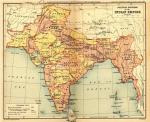Three kinds of land revenue were introduced by the British in India- the Permanent Settlement, Mahalwari settlement and the Ryotwari system.
The word Mahalwari is derived from the term Mahal, referring to a neighborhood or quarter. Under this system the unit for revenue settlement is the village. The village lands belongs jointly to the village community technically called the body of co-shares. The body of co-shares is jointly responsible for the payment of land revenue though individual responsibility is always there. If any co-sharer abandons his land it is taken over by the village community as a whole. The village community is the owner of village “common land” including the forestland, pastures etc. However the Mahalwari system of land revenue was prevalent in northern part of India.
Lord Cornwallis concluded the Permanent Settlement Act of 1793. Permanent Settlement was a grand contract between the East India Company and the Landholders of Bengal (Zamindars and independent Talukdars of all designations). Under this act, the landholders and Zamindars were admitted as the absolute owners of landed property to the colonial state system. Not only those, the Zamindars and landholders were allowed to hold their proprietary right at a rate that never changed. Under this contract of Permanent Settlement, the Government could not enhance the revenue demands on Zamindars.
The Permanent Settlement Act brought the improvement of the lands by the landowners as they took care of drainage and irrigation. Construction of roads and bridges were encouraged which were lacking in the state of Bengal. As the land revenue got fixed zamindars could securely invest the rest of the money to increase their income without the fear of tax increment. Corwallis made the motivation of the company clear by stating “when the demand of government is fixed, an opportunity is afforded to the landholder of increasing his profits, by the improvement of his lands.” The earning of company was thus assured as there were no shortage in the revenues due to defaulting Zamindars, who fell into debts as they could not fix their budged due to fluctuation of revenue.
The ryotwari system, instituted in some parts of British India, was one of the two main systems used to collect revenues from the cultivators of agricultural land. These revenues included undifferentiated land taxes and rents, which were collected simultaneously. Under the Ryotwari system of land revenue settlement, every registered landowner were called proprietor. These proprietors were responsible for the direct payment of the land revenue to the state. The Proprietor had the right to sub let his land holdings, or to transfer, mortgage or to sell it. A proprietor holds the land till the government wanted him to be the Proprietor. In case if the Proprietor failed to pay the state demand of the land revenue, he was evicted from the office.
The Ryotwari system of land revenue introduced by Munro operated for nearly thirty years. According to the historians though the Ryotwari system was flexible than the Mahalwari system, yet it caused oppression and agricultural distress. The peasantry was shattered and subjected to utter poverty. Hence they became the subjects of the chetty or the moneylenders to pay off the land revenue to the state. Thus the Ryotwari system of land revenue gave rise to a group of moneylenders, who were no less the oppressors. The machinery of collection of the land revenue or the return s of the moneylenders was too oppressive.


